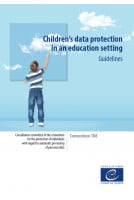A handbook to support the implementation of Recommendation CM/Rec(2018)7 of the Committee of Ministers of the Council of Europe on Guidelines to respect, protect and fulfil the rights of the child in the digital environment
Since 2016, the Council of Europe has worked towards the promotion of the rights of the child in the digital environment through its Strategy for the Rights of the Child (2016-2021). A key instrument in this regard are the Guidelines to respect, protect and fulfil the rights of the child in the digital environment adopted by the Committee of Ministers as CM/Rec(2018)7 in 2018. These Guidelines have since been praised on as one of the most comprehensive sets of standards in this area. They are particularly appreciated for taking a balanced approach combining the protection of children in the digital world with the promotion of their positive rights as end users of digital technologies.
Complementing the Guidelines and their child-friendly version “Learn about your rights in the digital environment” published in May 2020, this handbook for policy makers underlines the importance for all public bodies, civil society and private stakeholders to adopt a common approach. Whether it be through national legislation or by developing strategic partnerships, the well-being of children in the digital environment needs to become a major joint concern for all stakeholders in the 21st century.
This handbook will help decision makers from a variety of backgrounds to support children by creating a digital world that truly respects, protects and fulfils the rights of the child. The handbook reminds them to regularly address newly emerging conditions and challenges, such as Artificial Intelligence, and proposes numerous resources and hands-on tools to check whether national legislation and policies are comprehensive and up-to-date.
FOREWORD A QUICK GUIDE TO RECOMMENDATION CM/REC(2018)7 FOR POLICY MAKERS CHAPTER 1 – INTRODUCING THE RECOMMENDATION AND GUIDELINES
1. What is this handbook about?
2. Why was a Recommendation needed?
3. What is a Recommendation by the Council of Europe and how is it prepared?
4. How does the Recommendation relate to international and European legal standards?
5. What is the aim of this handbook?
6. Explaining key terms
7. Which information and communication technologies are relevant to children’s rights?
8. What do children say?
9. What does the evidence show?
10. How is this handbook organised?
CHAPTER 2 – NATIONAL FRAMEWORKS
1. Legal frameworks
2. Policy and institutional frameworks
3. Cooperation and coordination at national level
4. Fundamental principles
CHAPTER 3 – OPERATIONAL PRINCIPLES IN PRACTICE
1. Access to the digital environment
2. Right to freedom of expression and information
3. Participation, right to engage in play and right to assembly and association
4. Privacy and data protection
5. Right to education
6. Right to protection and safety
7. Remedies
CHAPTER 4 – INTERNATIONAL COOPERATION AND COORDINATION
1. Ratification and implementation of UN/CoE Conventions
2. Cooperation with other States
3. Cooperation with the Council of Europe
4. Cooperation with intergovernmental bodies, transnational networks and other international organisations
CHAPTER 5 – ENGAGING WITH BUSINESS ENTERPRISES IN FOCUS: ADVANCES IN ARTIFICIAL INTELLIGENCE (AI) AND IMPLICATIONS FOR CHILDREN’S RIGHTS








